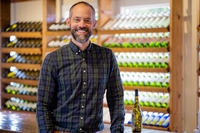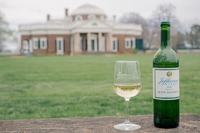What are the chances that a secondary Bordeaux grape, one which seldom gets any attention except for being a small percentage in a Medoc classified red blend, and a white grape infrequently grown outside the backwaters of France’s Southwest appellations would together become showcase varietal wines on America’s East Coast, particularly in Virginia and Pennsylvania?
Or that they would share the diminutive first name of “Petit” – Petit Verdot and Petit Manseng?
Yet, of the 12 highest-rated wines in the 2023 Virginia Governor’s Cup competition, three were varietal Petit Verdots and two were Petit Mansengs – together almost half of the showcased 12. “Petit Manseng is our (Virginia’s) seventh most-planted grape, but the third most-planted white grape,” says Susan Kramer, senior marketing manager for the Virginia Wine Board. “We have about 200 acres of it under vine. Petit Verdot is our third most planted grape, with 487 acres under vine.”
It should be noted, of course, that other than sharing a first name and their adaptability and growing popularity in the same broad winegrowing region, the two Petits would have nothing genetically in common should anyone administer a 23andMe test.
While even the most casual lover of red Bordeaux knows Petit Verdot is one of a handful of “blending grapes” grown chiefly in the Medoc on the Left Bank, it wasn’t until a dozen or so years ago that I had tasted a varietal Petit Manseng while I was on a tour of the small regions of France’s Southwest (South West – they spell it both ways), in the shadow of the Pyrenees.
Recently I talked with the winemakers who made two of the 12 Virginia winners, one each for Petit Manseng and another for Petit Verdot, about their experiences with the grapes.
Jefferson Vineyards Petit Manseng
Chris Ritzcovan joined the winemaking team at Jefferson Vineyards in 2007 and was named winemaker in 2013. Located near Monticello, the third President’s

home, the winery and its vineyards, which made its first wine in the mid-1980s, were purchased earlier this year by the Thomas Jefferson Foundation.
“About a half-acre of Petit Manseng was planted about 20 years ago, before I came here,” Ritzcovan says. “At first it was used to blend with Viognier. Now we have close to two acres, the most recent being planted five or six years ago.”
In the vineyards, Ritzcovan says, “Manseng doesn’t grow very upright, and it looks like a jungle. Fortunately, it has a thick skin and is not prone to mildew. We have it on VSP and do spur pruning.”
Petit Manseng, Ritzcovan and others growers say, develops oddly and provides winegrowers with a dilemma – or perhaps an opportunity – to make a dry wine or to make a sweet one, even if inadvertently. “It’s a bit of an anomaly,”

Ritzcovan says, “because it can get to a very high level of sugar while retaining its acidity. As a result, it can be hard to ferment to complete dryness – one to one-and-half percent sugar may remain.”
Because of this, Manseng is picked early at Jefferson, and Ritzcovan works in the cellar “to soften the acidity a bit. We try to pick around 23 Brix, so that’s earlier than the other varieties,” he says, “and we general keep it in whole clusters.” Ritzcovan says he has used different yeasts to tame the acidity during fermentation in neutral-oak barrels.
“At first, Petit Manseng was a harder sell to our tasting room customers,” Ritzcovan says, “until they taste it.”
Barren Ridge Vineyards Petit Verdot
Petit Verdot and Merlot were the first grapes planted in 2007 at Barren Ridge Vineyards when it was established at Fisherville in the Shenandoah Valley across the Blue Ridge from Charlottesville. Jessi Gatewood began her career at Barren Ridge in 2014, left briefly in 2016, and returned in 2019 as winemaker.
“When I got started, everyone was high on Cabernet Franc,” Gatewood says, but she and a lot of her fellow winemakers have since become enamored by Petit Verdot. “It has good extract and good tannins, and we all seemed to discover it

at the same time,” she says. “I love the aromatics. It’s so floral and even delicate for such a big wine.”
In the vineyards, Gatewood says she keeps crop levels lower than with her other varieties, even though, she says, PV doesn’t have a lot of the green characteristics that other Bordeaux varieties can exhibit. “And it’s more amenable to the weather,” she says. “We had a hurricane in 2015 and were able to pick half the crop early, before the hurricane. We were able to cover up some of its green notes with oak. But after the hurricane, we picked the rest of the crop, and it was much more interesting, lush and complex.”
Gatewood says Barren Ridge has about two acres of PV, and she tries to hold yields to three to four tons per acre. “In the cellar, I typically do multiple lots using different yeasts,” she says, “but D254 seems to be the one that brings out the floral charcetristics.” The cooperage, she explains, comes from a French barrel maker using Virginia oak. “I swear, I can almost taste the vineyard dirt,” she says.
A Note from Pennsylvania
For a summation of the two Petits, I asked my friend and almost-neighbor, Anthony Vietri, to relate his experiences. Over the past 25 years, Vietri, the proprietor and winemaker at Va La Family Farmed Wines, has at least test-grown dozens of grape varieties and clones on his five-acre vineyard in Avondale, PA.
“We first planted Petit Verdot in 1999 and Petit Manseng a few years after that,” Vietri says. “Although, at the time, both had some negative reputations – purported inability to ripen consistently, high acids, and so on – we loved how both grew on our site and readily began expanding clonal selections of both.
“In 25 years, we have seen few issues with either,” he continues. “We have occasionally seen a propensity for manganese deficiency (as opposed to magnesium) and phomopsis [a type of fungus] in PV, but neither have been a deadly threat. In PM, we get a bit greater degree of downy mildew than the average.”
He concludes, “When grown as large vines, both varieties can be vigorous, with floppy shoot growth and large leaves that can have a tendency to cause shingling in the canopy. Both are on the high end of cold hardiness for our vinifera and show very low cluster rot due to tiny berries and loose clusters. Both varieties accumulate high tannins, sugar and acids, with PM having monumental acids that have to be managed. Yield can be inconsistent with each; due to the small clusters frost damage (or weak set) can lead to small-yield years.”
As Vietri likes to make vineyards blends of varieties, rather than varietals, each figures prominently in his branded blends.
As in Virginia, neither Petit seems to miss their homelands in France.